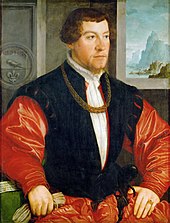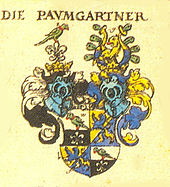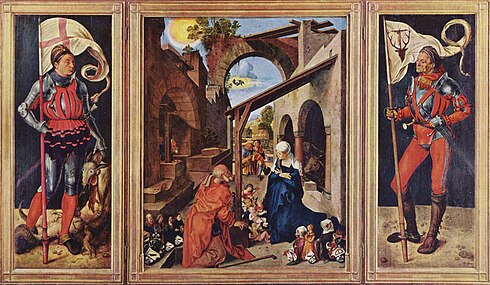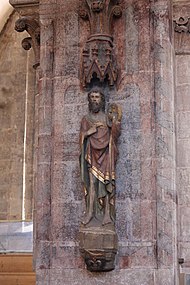Paumgartner (patrician)

The Paumgartner or Baumgartner (also: Paumgartner von Holnstein and Grünsberg ) were one of the oldest patrician families in the imperial city of Nuremberg . They are first mentioned in a document in 1255, from 1396 they were represented in the Inner Council until they died out in 1726 and thus belonged to the Nuremberg patriciate and, according to the dance statute of 1521, to the new sexes eligible for advice.
After his bankruptcy, Anton Paumgartner went to the imperial city of Augsburg around 1475, as did Sebald Paumgartner († 1520) later, where the Paumgartner family were accepted into the Augsburg patrician family in 1538 .
In 1726 the family died out in Nuremberg.
In Nuremberg the “Paumgartnerstraße” , in Augsburg the “Baumgartnerstraße” is named after them.
Family coat of arms
Divided by silver and black, above a green parrot with a red beak, red feet and a red neck ring, below a silver lily.
history
Origin and Nuremberg Line
Like many of the Nuremberg families and later patrician families (see also: Imhoff , Oelhafen , Scheurl and Petz ), the Paumgartners came from the area around Lauingen in Swabia. Heinrich Paumgartner was mentioned in a document in Nuremberg in 1255 as the first representative of the family. Like many Nuremberg patricians, they later became involved as long-distance traders. In Venice they had their own chamber of commerce in the Fondaco dei Tedeschi from the late 14th century together with the Kreß . In the middle of the 15th century, the Nuremberg-Augsburg trading company Paumgartner-Arzt-Gossembrot is documented. This trading company ended in 1450 and the individual partners founded their own companies. In Nuremberg, under the direction of Konrad Paumgartner d. Ä. a family company that he and his sons Konrad d. J. and Anton I. led. In 1465 this family company ended with bankruptcy and the flight of Anton Paumgartner, who had meanwhile risen to become the head of the company, from the imperial city of Nuremberg.
The most important representative of the Nuremberg family was Hieronymus the Elder Paumgartner (1498–1565). He represented Nuremberg at the Diets in Speyer in 1529 and Augsburg in 1530, as well as in the revision of the constitution of the Schmalkaldic League in 1536. As a young councilor, he was already a leader in the takeover of the Reformation in Nuremberg ( religious talk 1525 ) and in the Palatinate offices of Allersberg, which were pledged to Nuremberg , Hilpoltstein and Heideck involved.
The Nuremberg Paumgartner acquired Holnstein in 1596, inherited Grünsberg Castle from the Haller von Hallerstein in 1672 and called themselves Paumgartner von Holnstein and Grünsberg from then on . In 1726 the family died with Johann Paul III. Paumgartner out. His widow, re-wed Haller, left the castle to her son-in-law Karl Christoph Stromer von Reichenbach in 1766 , who took over her considerable debts. To this day, numerous culturally and historically valuable memorabilia from the possession of the Paumgartners have been preserved at Grünsberg Castle, which is now owned by the Stromer Foundation.
Augsburg line

The Nuremberg Paumgartner went bankrupt in 1465 and Anton Paumgartner, the last head of the family company, settled in Augsburg, where his family can be traced from around 1475.
Anton's son, Hans I. (* 1455 in Nuremberg, † 1527 in Augsburg), married Felizitas Rehlinger from Augsburg in 1485 and thus founded the line that is based here. Trade in goods, mining and financial transactions, the latter especially with the Habsburgs, became the foundation of their new fortune, one of the largest in the late Middle Ages. In 1498, Hans I. participated in the first German copper syndicate with the Fuggers and the Gossembrot and in 1505 financed Balthasar Sprenger's trip to India with the Welsers . He was a member of the guild of merchants, 1502 imperial council and 1505-1516 in the city council of twelve. All of his children married members of wealthy merchant families, e. B. the Fugger and the Welser.
After his death, the family business was managed by his son Hans II (* 1488 in Augsburg, † 1549 in Schwabmünchen ). After training as a businessman in Italy, France and England, he married Regina Fugger in 1512, the only daughter of the rich merchant Georg Fugger († 1506) and niece or ward Jakob Fugger the Rich († 1525). Under his leadership, the importance of the trading house Paumgartner / Baumgartner increased, especially the financial relations with the Habsburgs and the involvement in Tyrolean mining were strengthened. Hans II was a member of the Great Council from 1520–1536, in 1535 he had acquired the rule of Schwangau with the ruinous Schwanstein Castle (today Hohenschwangau Castle ) from King Ferdinand I. He had this renovated and expanded in the Italian style from 1538 to 1547 by the Neapolitan master builder Lucio de Spari. In 1537, Hans II was raised to the baron status by Emperor Karl V , with the title Paumgartner von Hohenschwangau to Schwanstein , and from then on also had a swan in his coat of arms. In 1538 he was officially admitted to the Augsburg patriciate. The historian Georg Sigmund Graf Adelmann von Adelmannsfelden calls him a "businessman of international standing" and "ruler of the then so important Tyrolean mining and metal trade" . In 1922, the "Literarisches Zentralblatt für Deutschland" (published by the German Booksellers Association ) named Hans Paumgartner II as the second richest man in Germany at the time, after Anton Fugger . He maintained contacts with humanists, including Erasmus von Rotterdam , worked as a patron of the arts and was a passionate supporter of the old church.
After his death in 1549, the sons Hans Georg and David took over the inheritance and took over the management. David Baumgartner (* 1517 in Augsburg, † 1567, in Gotha), served as Mayor of Augsburg in 1548/1549, in 1549 he became imperial council, in 1550/51 he sat on the secret council of the imperial city. After he was increasingly in the imperial service from 1547, he gave up Augsburg citizenship in 1552.
The assignment of the Tyrolean mine shares to Herwarth von Bittenfeld in 1553 led to a collapse of the Paumgartner's assets, at the end of which in 1562 the bankruptcy caused by the collapse of the Herbrot trading house , whose main creditors were David Baumgartner. He finally joined the political and economic adventurer Wilhelm von Grumbach and participated in his warlike ventures . With it, he fell to the 1563 imperial ban and was in the marketplace of 1567 Gotha beheaded. (See also Taler on the capture of Gotha (1567) #Tentzel's explanation .) David Baumgartner left a widow and 10 children, his brother Hans Georg (1515–1570) came to Augsburg in the debt tower and until 1570 in prison. Their descendants left the city, remained impoverished and had largely forfeited their father's goods.

Sebald Paumgartner († 1520) also came from Nuremberg to Augsburg and founded a branch of the family there. He was the son of Michael, the younger brother of Anton Paumgartner (progenitor of the Augsburg main line), who emigrated to Augsburg after the Nuremberg bankruptcy of 1465. Sebald's cousin Hans I. Paumgartner (1455–1527) arranged for him to marry the heir to the heir to the wealthy Augsburg merchant Balthasar Wolf in 1494 , whose entire fortune fell to him. He bought u. a. the village of Hausen and the Oggenhof . He had a personal friendship with the humanists Johannes Cuspinian and Willibald Pirckheimer .
His son Christoph Paumgartner the Younger († 1586) had himself portrayed in 1543 on linden wood by Christoph Amberger . This painting hangs today as a treasure in the Kunsthistorisches Museum Vienna . He was married to Sibylla Imhoff , after her death to Sabina Rehlinger .
Christoph's sister Anna († 1575) married Sigmund Langenmantel vom Sparren († 1545), district judge and ducal caretaker in Kelheim , where her epitaph has been preserved in the parish church of the Assumption of Mary . His brothers were the Baden court master and Bavarian councilor Ulrich Langenmantel vom Sparren and the canon Christoph Langenmantel , who helped Martin Luther to escape from Augsburg in 1518.
Former possessions (extract)
- 1449–1489 Oedenberg near Lauf an der Pegnitz
- 1520–1610 Baumgarten Castle near Aislingen - Augsburg line
- 1535–1561 Schwanstein Castle in Schwangau (today Hohenschwangau Castle ) - Augsburg line
- 1596–1726 Holnstein Castle (district of Amberg-Sulzbach)
- 1672–1726 Grünsberg Castle
- 1677–1687 the Pellerschloss in Fischbach
- Possessions around Lonnerstadt
Foundations (extract)
- Paumgartner window in Nuremberg's Lorenz Church , donated by Conrad VI in 1456. Paumgartner
- The Paumgartner Altar - a late Gothic triptych from the Katharinenkirche , donated by Martin Paumgartner, created by Albrecht Dürer until 1498 (today Alte Pinakothek , Munich)
The Paumgartner Altar by Albrecht Dürer (1498)
Known family members

- around 1380–1464 Konrad Paumgartner, first Nuremberg councilor of the family
- Hieronymus the Elder (1498–1565), acquaintance of Philipp Melanchthon and Martin Luther, 1533 old mayor, 1549 elder gentleman, 1553 third captain.
- Hans II. Paumgartner (1488–1549), Augsburg patrician and imperial councilor. In 1535 he bought the imperial direct rule Schwanstein with the dilapidated Schwanstein Castle and had it rebuilt from 1538–1547 to form Hohenschwangau Castle . Thereupon he was raised to the rank of baron Paumgartner von Hohenschwangau by Emperor Karl V in 1537 .
- 1613–1686 Andreas Georg Paumgartner , Nuremberg councilor, Losunger
literature
- Christoph von Imhoff (Hrsg.): Famous Nuremberg from nine centuries . Nuremberg: Hofmann, 1984, 425 pages, ISBN 3-87191-088-0 ; 2., erg. U. exp. Edition, 1989, 459 p .; New edition: Edelmann GmbH Buchhandlung, October 2000
- Otto Puchner: Baumgartner. In: New German Biography (NDB). Volume 1, Duncker & Humblot, Berlin 1953, ISBN 3-428-00182-6 , pp. 663-665 ( digitized version ).
- Michael Diefenbacher , Rudolf Endres (Hrsg.): Stadtlexikon Nürnberg . 2nd, improved edition. W. Tümmels Verlag, Nuremberg 2000, ISBN 3-921590-69-8 ( online ).
- Ina Schönwald: Studies on the Paumgartner patrician family at Grünsberg Castle. Reflections on the self-image of the Nuremberg patriciate in the first third of the 18th century: Lauf 2002 (series of publications by the Altdorf City Archives).
Web links
- The Paumgartner / Baumgartner in the Augsburger Stadtlexikon
- The coat of arms of the Paumgartner
- Holnstein Castle
- Grünsberg Castle on the side of castles and mansions in the Nuremberg countryside (Giersch / Schlunk / von Haller)
Individual evidence
- ↑ Herrensitze.com : Grünsberg Castle (Giersch / Schlunk / von Haller)
- ↑ Norbert Lieb: Die Fugger and the art , Volume 1, p. 52 u. 53, Verlag Schnell & Steiner, 1952; (Detail scans)
- ^ Georg Sigmund Count Adelmann von Adelmannsfelden : Castles and Palaces in Württemberg and Hohenzollern , Volume 9 of: Burgen, Schlösser und Herrenssitz , W. Weidlich Verlag, 1959, p. 88; (Detail scan)
- ↑ Website for Hohenschwangau Castle ( memento of the original from March 13, 2013 in the Internet Archive ) Info: The archive link was inserted automatically and has not yet been checked. Please check the original and archive link according to the instructions and then remove this notice.
- ^ Georg Sigmund Count Adelmann von Adelmannsfelden: Castles and Palaces in Württemberg and Hohenzollern , Volume 9 of: Burgen, Schlösser und Herrenssitz , W. Weidlich Verlag, 1959, p. 88; (Detail scan)
- ^ Literarisches Zentralblatt für Deutschland , p. 268 of the year 1922; (Detail scan)
- ↑ Christian Jakob Wagenseil : Memorabilia from history for every day in the year , Volume 1, Part 1, p. 169, Sulzbach, 1820; (Digital scan)
- ^ Heinz Scheible : Melanchthon's correspondence: Biographischer Index , Verlag Frommann-Holzboog, 1977, p. 123 u. 124, ISBN 3772822576 ; (Digital scan)
- ^ Wilhelm Krag: The Paumgartner of Nuremberg and Augsburg: a contribution to the trading history of the XV. and XVI. Century , Duncker & Humblot, 1919, p. 1590
- ^ Friedrich Battenberg, Bernhard Diestelkamp: The protocol and judgment books of the Royal Court of Justice from the years 1465 to 1480 , Volume 1, p. 1721, Böhlau Verlag, Cologne, 2004, ISBN 3412125024 ; (Digital scan)
- ↑ Ibid., P. 1516; (Detail scan)
- ↑ Display for customers of the German prehistoric times , Germanisches Nationalmuseum, Nuremberg, Volume 8, 1861, column 231 (digital scan)
- ^ Helga Scheible: Willibald Pirckheimers Briefwechsel , 2nd volume, p. 553, CH Beck Verlag, 1956; (Detail scan)
- ^ Hans Ankwicz von Kleehoven : Johann Cuspinians Briefwechsel , p. 68, Beck Verlag, 1933; (Detail scan)
- ^ Website for the portrait of Christoph Paumgartner
- ^ Jacob Strieder, Heinz Friedrich Deininger: Das rich Augsburg: selected essays by Jakob Strieder on the Augsburg and South German economic history of the 15th and 16th centuries , Duncker & Humblot, 1938, p. 205; (Detail scan)
- ^ The Chronicles of the German Cities: Augsburg , p. 406, Hirzel Verlag, 1917, (detail scan)
- ^ Johann Seifert : Hoch-Adeliche Stamm-Taffeln , Part 3, Regensburg, 1726, 2. Stammtafel der Langenmantel; (Digital scan)
- ^ Felix Mader: Die Kunstdenkmäler von Niederbayern: Bezirksamt Kelheim , Oldenbourg Verlag, 1922, p. 172; (Detail scan)
- ^ Entry on Baumgarten Castle in the private database "Alle Burgen". Retrieved November 30, 2016.
- ↑ History of Hohenschwangau Castle ( Memento of the original from March 13, 2013 in the Internet Archive ) Info: The archive link was inserted automatically and has not yet been checked. Please check the original and archive link according to the instructions and then remove this notice.
- ↑ Holnstein Castle






